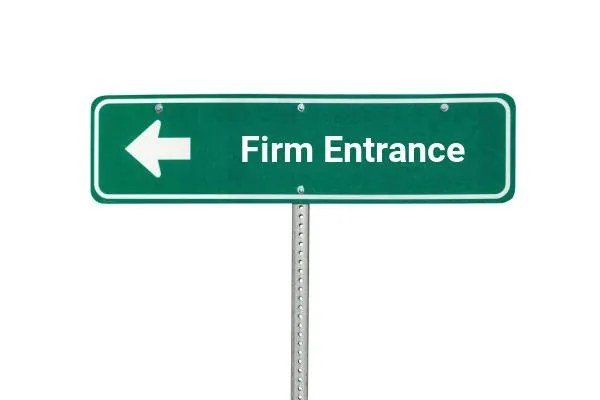
Exit Planning for Small Law Firms: Part 1
BEGIN WITH THE END IN MIND
A recent survey of sole and small law firm owners suggested that 40% of attorneys over the age of 50 would like to retire within 10 years. Fifty percent (50%) of those surveyed indicated that having an exit plan was extremely important, 30% very important, and 20% somewhat important. Yet, 50% of those attorneys are not satisfied with their own current plan.
Several years ago, the PA Bar added a question about attorney exit strategies on the license renewal application. Although there is no requirement to have a formal succession plan, the disciplinary board wants to encourage attorneys to give careful thought to the continuing ethical duties created by the PA Rules of Professional Conduct. The most basic requirement for an exit plan is to name a successor attorney or firm to assume responsibility for the interest of clients in preparation for an unanticipated death or disability.
Medium and large firms will most likely groom associate attorneys to take over for departing partners, thus allowing the firm to continue as a going concern when an owner departs. However, solo practitioners and small partnerships struggle with what to do when an Owner is ready to retire. In the survey, one of the top concerns about exiting the practice of law is not knowing how to divest themselves of the business.
This article is the first of a two-part series on exit planning for solo practitioners and small firms:
Part 1: Begin with The End in Mind will address the actions that these firms should take now in preparation for a smooth transition to a successor in the future.
Part 2: Taking the Exit Ramp will layout a framework for creating and executing an exit plan for those who are near the finish line. It will provide some recommended actions that can be taken to overcome the common obstacles to retirement for small firm owners.
Part 1: “Begin with the End In Mind” Steven Covey
Steven Covey’s first two Habits of Highly Effective People are: Be Proactive and Begin with the End in Mind. The way I see it, small or solo firms have two basic options when it comes to proactively managing your practice. Your choice will depend on your personal goals and ambitions:
OPTION A
GOAL: Create a job for yourself so you can trade your time for money until you save enough to retire.
STRATEGY: Keep overhead low and focus only on practicing law without intent of creating a salable entity.
OPTION B
GOAL: Create a business that has the potential to generate a profit beyond your own hourly rate.
STRATEGY: Invest in your business infrastructure with the intent to sell it in whole or in part at some point in time.
If you are leaning more towards OPTION A, then you can probably skip the rest of this article and focus on Part 2. But if you are interested in OPTION B, then I suggest you read on.
According to Robert Dulay of HBK Valuation group, the most applied valuation approach to law firms is the Income Approach. There are two methods under this approach: the Single Period Capitalization Method and the Discounted Cash Flow Method.
a. Single Period Capitalization Method: Assumes a normalized cash flow will grow at a sustainable rate into perpetuity. Value is then determined by dividing the Company’s sustainable return by a capitalization rate. The greater the uncertainty, the higher the discount rate, which will subsequently decrease the value of the Company.
b. Discounted Cash Flow Method: Projects cash flows over multiple years, typically three or five years for a law firm. As such, this method captures periods of high but unsustainable growth or any other unusual fluctuations in cash flow, after which operations are assumed to stabilize in a terminal year. Value is then determined by discounting the future cash flows by the appropriate required rate of return and summing the values together. Overall, firm value is positively related to cash flows and negatively related to the discount rate.
Therefore, I would assert that the key to creating value for a small law firm is to establish sustainable profitability and growth potential that can be transferred to a new owner. To do that, you need to establish a turn-key operation. You can think of it like staging your house for sale – it will be more valuable if the roof doesn’t leak, the electrical, plumbing and gas systems work, the flooring is in good shape, appliances are modernized, and the house is clear of all the junk you have accumulated over time.
“The entrance strategy is actually more important than the exit strategy.” Edward Lampert.
Establishing a business infrastructure that will have value when you’re ready to exit takes time and effort throughout the life of the firm. To develop a turn-key practice, you’ll need to establish the four cornerstones of a business. These cornerstones are marketing, human resources, financials, and processes.
Marketing Systems:
What’s in a name? Well, a lot when it comes to selling a business. I know that the tradition is to name the firm after yourself and your partners. But what value will that have when you are no longer practicing law? Consider naming the firm something on which you can build a brand that does not rely on your direct involvement. For example, instead of Mary Smith Law for a family law firm, go with something like Family First Law.
Also, your branding, website, lead generators, ROI tracking, client list and referral relationships are valuable. So are investments in the automation of the sales funnel and intake process. Having an effective client relationship management system supports ongoing revenue generation. Think about when you first started out on your own. How valuable would it have been to have effective marketing systems already in place?
Fifty percent (50%) of the owners who responded to the exit planning survey indicated that they are likely to consider merging with a larger firm as an exit strategy. In a merger situation, your client and referral source relationships as well as the ability to transfer that goodwill to the larger firm will be key. Thus, establishing and nurturing those relationships should be part of your marketing strategy now.
Human Resources:
Associates, paralegals and assistants who are well trained and profitable will also add to the ability for a new owner to generate revenue. Make sure your employees have ongoing contact and established relationships with your clients. Also, track how much they contribute to the firm’s bottom line (their contribution margin) so you can demonstrate value to prospective buyers or partners. Your turn-key operation will depend on your support staff, who should be able to run all administrative aspects of the firm independent of your involvement.
Also, think about the value of your human resource system itself. Be prepared to show a prospective partner or buyer that you have established reliable recruiting, hiring, onboarding and performance management systems. Furthermore, establish competitive wage and benefit plans. It can take years to get these things in place. Investing in your people management processes will pay off now and in the future.
Financials:
Any serious prospective buyer for your business will ask to review your financial statements. Keeping accurate financial records throughout the life of the firm will allow you to make a clear representation of its ability to generate profit over the years. Start with establishing the systems that will allow you to track and report on all the key financial metrics including Profit & Loss, Assets, Liabilities, Equity, Accounts Receivable and Payable, and timekeeper statistics. Automating financial procedures and creating meaningful reporting mechanisms will be attractive to buyers or potential partners.
Maintaining clean accounts payable and receivable records will also be key to building the value of your firm by demonstrating liquidity. To keep these under control, establish policies and procedures that govern how expenses are paid and outstanding accounts receivable resolved. Make sure you can prove that your timekeeping, billing, and collection system is effective and that you employ a reliable cash flow projection model.
If you have IOLTA accounts, be sure to establish procedures that will ensure your records are accurate. Establishing a three-way reconciliation system and keeping up with unclaimed funds will make a firm transition much easier than if you have a plethora of discrepancies and uncashed checks to deal with. If you already have some imbalances, make a cleanup plan and implement better tracking methods.
Finally, consult with a tax advisor on how to minimize taxes while still retaining earnings that result in a growing equity balance. In addition, all firms will need to borrow money now and then for various reasons. Pay attention to your debt to equity ratio AND to the interest rates you’re paying on any loans, credit cards, lines of credit, etc.
Processes:
There are two aspects to establishing processes that create the repeatable revenue generation needed to sustain firm value regardless of the original owner’s time and rate: technology and documentation. Implementing the right technology will streamline workflow and automate tasks. Documentation of processes and procedures will ensure that your systems continue to work as designed even when staff turnover happens. When contemplating the investment of time and money into technology, workflow design and process documentation, keep in mind how it will add perpetual value for your firm.
One particularly important policy to document and implement is an effective file closing and destruction process. It is essential to keep storage costs to a minimum while also meeting retention obligations. Furthermore, maintaining accurate records of past clients and matters will be necessary when checking for conflicts of interest when a new partner joins or you merge with another firm.
Conclusion:
If you aim to establish a business that continues to have value when you are ready to exit the practice, you must develop turn-key systems in marketing, human resources, financials, and processes. When making decisions to invest in these systems, keep the long-term goal in mind in addition to the short term benefits they will provide. I recommend that you keep track of the direct expenses involved in establishing your business infrastructure as well as your and your staff’s time. You can do so by creating nonbillable matters in your billing software specific to each administrative system and recording the time spent. Being able to show the value of your time in getting those systems in place will be priceless when it comes time to divest yourself of all or part of your firm.

overcome chaos
increase profits
reclaim time
